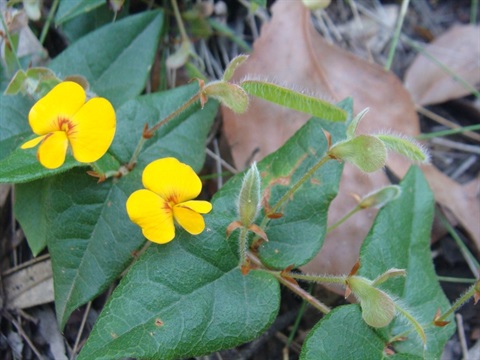
Platylobium reflexum
Victorian Flat-pea
Weakly erect shrub, tallest when supported by other shrubs. Hairless to densely downy stems.
Additional information
- Synonympreviously included in P. formosa
- FamilyFabaceae
- StoreyLower storey
- Size1-2 m x c. 1m
- Plant groupingShrubs to 2m
- LeavesMostly paired, shortly stalked (1-3 mm long) egg-shaped leaves, ending in a short non-prickly point, 2-6 cm x 1.5-4 cm. Base heart-shaped to straight, margins curved down.
- Flower colourYellow with red centres
- Flowering timeSeptember to December
- Flowers1-4 large pea flowers in leaf axils on downy stalks 1-3.5 cm long extended above basal bracts and scales. Small flatish orange-brown bracts with parallel ridges overlapping base of calyx, tips turning down (reflexed) at or after flowering. Wings all yellow. Fertile
- Bird attractingNo
- Butterfly attractingNo
- Frog habitatNo
- Growing conditionsMoist soils in tall wet forests.
- Garden useBright flowers for a shady moist garden or bush area. Can scramble amongst other shrubs.
- Commercially availableNo information available
- Conservation statusUncommon and little known within the Shire
- Related speciesSee P. obtusangulum for information on P. formosum. Platylobium montanum occurs either just within or outside the Shire boundary. This may change as specimens are identified. The small bracts below the calyx are convex, smooth and brown to reddish-brown. There are 2 subspecies: ssp. montanum occurs in the high country with a collection at Lake Mountain. It is similar to P. reflexum. Leaves are strongly heart-shaped at the base, flower stalks distinct, 5-15 mm long. Fertile. Ssp prostratum is prostrate and suckering with few flowers on stalks 15-25 mm long, rarely producing fruit. Leaf bases are shallowly heart-shaped to rounded. It occurs in the Steels Creek area.
Photo Gallery
Photographer/s: David Lockwood, Royal Botanic Gardens Board ©
Plant Communities